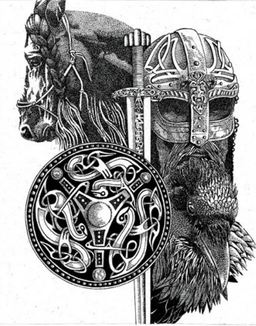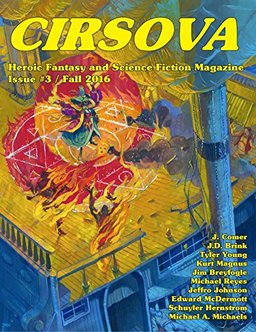September Short Story Roundup
 We’re still in the midst of a swords & sorcery renaissance that started around a decade ago, and now there’s a broader pulp one going on as well. Between the first issue of Skelos and the third of Cirsova, September saw a hurricane of short stories involving swords, wizards, warriors, pirates, and space pirates. Good times ahead! At least that’s my hope.
We’re still in the midst of a swords & sorcery renaissance that started around a decade ago, and now there’s a broader pulp one going on as well. Between the first issue of Skelos and the third of Cirsova, September saw a hurricane of short stories involving swords, wizards, warriors, pirates, and space pirates. Good times ahead! At least that’s my hope.
I first became aware of Skelos‘ then-impending existence with a flurry of internet activity announcing a Kickstarter this past spring. On the pledge page the magazine was heralded as “A horror and fantasy journal featuring short fiction, essays, poetry, reviews, and art by both seasoned pros and talented newcomers!” I found those words impossible to resist, and kicked in enough money to get myself billed in its pages as a benefactor, and be rewarded with a print copy and a four-issue e-book subscription.
When the print copy of Skelos 1 appeared in my mailbox last month, I was very impressed with its look and feel. The cover is decorated with a nicely creepy Gustav Doré illustration and the inside is filled with great black and white art.
Skelos is edited by a triumvirate comprising Mark Finn, Chris Gruber, and Jeffrey Shanks, but the introduction was written by Finn alone. The co-editors are looking to have an an ongoing conversation with their readers and are “willing to learn as we go, if you’re willing to talk to us about the thoughts behind the words and pictures. We want everyone to walk away feeling like they learned something new, or at least, were heard and understood.” It may be “too ambitious to try and bridge the gap between Classic Weird Fiction and New Weird Fiction,” but where they intersect is what the trio find interesting, and what Skelos intends to investigate. While there are very specific references to authors and artists from the early days of weird fiction (Lovecraft, Moore, Bok, and Finlay), there aren’t any contemporary ones. If that sounds a little vague, I believe it’s deliberate, as Skelos is still a work in progress.
The opening story, “The Dead Unicorn” by Scott Cupp, is not my cup of tea. It’s a sort of mood piece I’d expect to find on the pages of Beneath Ceaseless Skies. A unicorn returns to where it was born. Unfortunately for the people living nearby, the unicorn is being hunted by hordes of demons. What follows is a boring catalogue of horrors.
On the other hand, Charles Gramlich’s “Hungry” is a bit of “Cold Equations” sort of sci-fi, but much creepier. How does a man on an asteroid outpost survive for two months when his food supply is destroyed? It’s a good story, but it doesn’t feel of a piece with any other story in the magazine.
“The Night Maere” by Scott Hannan is a well-told first-person horror tale. The narrator makes the mistake of extending a helping hand to the wrong friend in the wrong house.
In “The Yellow Death,” by David Hardy, plague has come to Philadelphia on the coattails of French refugees from the Haitian Revolution. With his own family dead from the titular disease, Doctor Richard Belford comes up with a novel way to combat it. He will seek out and eliminate the physical personification of the Yellow Death. Based on a historical epidemic, this is a good, horrid depiction of all-consuming madness.
Matt Sullivan’s “The Burning Messenger” gives us a town of familiar Nordic barbarians whose only hope lies with the aged warrior Bronyr and the young woman, Hielvun. A young boy returns to the village shocked and barely able to speak. When he finally manages, he shrieks that all the town’s warriors are dead. He also talks of burning green eyes and Thorgrik, leader of a rival town. Good, brutal swords & sorcery action ensues.
After “The Dead Unicorn,” the story I enjoyed the least was “Dangerous Pearl” by Ethan Nahté. A boatload of pirates with names like Manatee and Whop-jawed Billy decide to explore the very worst island possible. The reason it is so bad is revealed in a finale more appropriate to a weaker issue of EC Comics than Weird Tales.
 The definite highlight of this inaugural issue of Skelos is veteran S&S scribe Keith Taylor’s “The Drowned Dead Shape.” As the story opens, Nasach the riever and his crew have just lost one man to an undead attacker and another has been driven mad. The five survivors are at sea in their small, stolen boat as things go from bad to worse. Shape-changing monsters, (understandably) irate villagers, and infighting pack this tale. The story builds up the tension gradually, ratchet turn by ratchet turn, until it explodes on a rocky beach:
The definite highlight of this inaugural issue of Skelos is veteran S&S scribe Keith Taylor’s “The Drowned Dead Shape.” As the story opens, Nasach the riever and his crew have just lost one man to an undead attacker and another has been driven mad. The five survivors are at sea in their small, stolen boat as things go from bad to worse. Shape-changing monsters, (understandably) irate villagers, and infighting pack this tale. The story builds up the tension gradually, ratchet turn by ratchet turn, until it explodes on a rocky beach:
They turned on each other once more.
“Enough!” Munro said, his voice shrill. He held Nasach’s spear in his hands. “Ye can’t fight! Ye can’t, or we’re all doomed! Are ye men? Him that strikes the next blow, I’ll gig him, on my oath!”
“I will be—” Conary began, sounding almost amused.
Then silence gripped his tongue, while the hair lifted on his scalp in sandy bristles of horror. Something rose out of the lough behind the boy, something pale-faced, with dripping hair, that seized Munro and dragged him backwards into the water. Nasach saw it too. With a snarl of hot rage he dove after them, nigh on top of them, knife in hand. This enemy, this monster, this thing, had followed them like the dogs of hell, had killed the woman, had sent them running for their lives and now wanted to destroy them before they escaped it across land. Munro was a fisher-lad, such a one as Nasach had been before pirates took him near Aran, and the demon was not having him.
“One Less Hand for the Shaping of Things,” by Jason Ray Carney, is a fairly standard fantasy romance. Ayolo is a merchant of limited ambitions. Only when prodded by his wife does he assemble a large caravan for distant markets, which is attacked and he left for dead. He survives with the help of a mysterious young girl named Jessa. Eventually the merchant recovers and takes Jessa with him back home. There are no surprises here, but the story’s well told and somewhat moving, as Babbitt-like, Ayolo tries to follow his heart.
 Finally, there’s the heavily illustrated “Grettir and the Draugr” by Samuel Dillon and Jeffrey Shanks. Again we’re in a familiar Nordic land, when Grettir the Strong arrives to save a town from an undead monster. The elements lifted from Beowulf add to the familiarity, but the art is good. The setting points to a problem with Skelos‘ fantasy: three of the five stories have Northern European type worlds — 2 Nordic, 1 Irish — which, no matter how well done, I’ve seen time and time again. In this day and age, and in a magazine that’s looking to explore some new, weird waters, I would have hoped to see something different.
Finally, there’s the heavily illustrated “Grettir and the Draugr” by Samuel Dillon and Jeffrey Shanks. Again we’re in a familiar Nordic land, when Grettir the Strong arrives to save a town from an undead monster. The elements lifted from Beowulf add to the familiarity, but the art is good. The setting points to a problem with Skelos‘ fantasy: three of the five stories have Northern European type worlds — 2 Nordic, 1 Irish — which, no matter how well done, I’ve seen time and time again. In this day and age, and in a magazine that’s looking to explore some new, weird waters, I would have hoped to see something different.
I won’t say much about the poems, other than that none of them has stuck in my mind. As to the several non-fiction articles, I have neither the time nor space to give them the attention they deserve. All are academic and dense. There is also a batch of book reviews, each written by a different writer. They cover fiction and non-fiction, both newish and older.
All my reservations aside, I’m glad I gave money to Skelos. This is a professional undertaking with a real feeling of sincerity, but it’s not There yet, wherever There turns out to be. I am looking forward to its evolution and growth over the coming issues. The next will feature work by Adrian Cole, a favorite of mine, and the always interesting W.H. Pugmire, so that’s pretty cool news.
If you don’t like pirate stories, Cirsova #3 is not the magazine for you. If you do, then plunk down your dollars, real or electronic, and get yourself a copy. Not as instantly gratifying as the previous two issues, Cirsova is still the real deal among the newbie magazines purveying action and adventure stories.
The first story, “War in a Way that Suits You” by Michael A. Michaels, doesn’t have a pirate in sight. A space mercenary has to fight his way out of the enemy-infested hot zone in order to get evacuated. In addition to fighting alien plant-men, he must bear the burden of abandoning his comrade, as per orders. Solid writing and some decent emotional heft make this well worth a read.
 Pirates make their first appearance in “The Lion’s Share” by J.D. Brink. Narrated by the grandly named Captain Leonidas Hawksblood, it tells how his spaceship, The Lion’s Share, came across a surprisingly well-defended freighter and what happened next.
Pirates make their first appearance in “The Lion’s Share” by J.D. Brink. Narrated by the grandly named Captain Leonidas Hawksblood, it tells how his spaceship, The Lion’s Share, came across a surprisingly well-defended freighter and what happened next.
Hawksblood chronicles the adventure in a mordant style I found as funny as its author intended; a great achievement.
Helpless. Innocents cast adrift on the Vast Empty Sea. Victims of circumstance in desperate need of a benevolent rescue. That was the ploy. A common pirates’ gag: the wounded kitten in need. Please come a little closer, see me bleeding here, salve my wounds, help me up… Taste my dagger. Ah-ah, I wouldn’t do that if I were you. Thanks for the assist, you’re too kind. Now hand over your purse and hold full of goods, thank you very kindly. Despite whatever heroic delusions you may be dreaming for us, ours is a villain’s lot.
We get pirates once more in “Blood and Bones: Caribbean 1645,” by Jim Breyfogle. Magic flashes across the decks in an alternate take on the late days of the New World buccaneers. Magician John Brennan offer his services and a plan to the notorious Captain Bones, of the wicked ship Blood ‘n Bones, in order to secure a great prize for himself: the daughter of the Cuban governor. I need more world-building in an alternate history than I found here. Without it, there was really no sense of why it was set in the Carribean, and I found my attention wandering, trying to puzzle that out instead of really giving heed to the story.
In “The Mad God’s Scepter,” by Edward McDermott, a ship and some of its passengers risk setting foot on a strange island to replenish supplies after a run in with pirates.
“A small one, only a few hours,” the Captain argued. “The pinnace will do the job nicely. My sailors will row and fill the casks. Some of your men should guard the party. I do not like this haunted harbor.”
“Why do you call it that?” Brant asked.
“Look at this anchorage. You could hide a fleet in here, safe from the worst storm. Yet no one uses it. Worse still, no one has mapped it. That means that no ship has ever returned from here with charts and logs since men have gone to sea. Surely we are not the first to come here, yet no report of this place exists. I will sleep better when I am in a known port, drinking wine and laughing at my own superstition.”
This is a minimum standard story as far as I’m concerned. The writing is engaging, the characters have enough individuality to stand out from one another, and there’s plenty of good, sword-swinging action.
“The End of the Golden Age,” by Tyler Young, has a central conceit I found too amusing to take as seriously as intended: when buccaneers first began sailing the Caribbean, twelve magical, talking parrots entered into deals with twelve human captains. The parrots would convey magical abilities to the captains in exchange for help keeping the Spanish and Portuguese away from their home island. Parrots — I got nothing else. There is one very good, mad image late in the story, but it came too late to overcome my head shaking.
Kurt Magnus’ “Othan, Liberator” opens in media res, with Othan, the would-be rescuer of a nobleman’s daughter, imprisoned. He’s also just about to learn that the object of his quest isn’t a prisoner, but somehow she’s become the leader of an evil cult (are there any good cults?). Nice, solid story that definitely needs a sequel.
Stepping back from action and adventure, the issue takes a turn toward urban fantasy in “Clock’s Watch,” by Michael Reyes. Unable to be seen by most people, and unmoored from normal time, Jerry Clock works hard to keep ghosts and other things inimical to humanity from getting loose in the waking world of present-day Coney Island. Reyes throws the reader right into the thick of things and hopes he’ll follow along. By the end I was very curious to learn more about Jerry Clock, and would like to read more of his adventures.
With a story in both previous issues, Schuyler Hernstrom returns in Issue 3 with a short short story about the final episode in a battle between the general, Attalse, and the space witch called “The Space Witch.” Not much to it, but the story’s written with what I’m coming to recognize as Hernstrom’s usual fine color and emotional resonance.
The concluding, and longest, story in the issue is J. Comer’s “The Wooing of Etroklos.” Swordswoman Sirat Tho’acnhur is sent by her master, the wizard Etroklos, to find him a wife. Most people are unaware Sirat is a woman, and it’s not even clear the wizard knows, but either way, he sends her on a special mission.
“Sirat, you are the dashing sort,” the old wizard, head shaved, beardless, had said. “The girls, now, they like you.”
“It may be so,” she’d said. A rats-and dragons board lay between them. She had taken the wizard’s boat; Etroklos had moved til her elephant-pig and two soldiers were her only hope. “But I’m sworn,” she went on, “not to share my bed. As you know, sir.”
The liver-spotted hand moved a soldier. “I know,” said the scholar-wizard who had harnessed the power of lightning to kill the soldiers of the Khus, with lore taken from the knowstones of the ancients. She studied the board, set for two players. “I do know that. And my proposal is this.” He sipped a yellow wine, which on another world was called “white”. “Go out; take you two tens of men. Manhorses, arms—draw what food you need from old Mrs. Vuzh. And find a bride for me.”
“Lord,” said the woman who lived and fought as a man, “if you seek a girl, then merely command. Enough will be brought here to the keep that you will wear out a bed testing them!” She dared a smile.
“And frighten the poor thing to death, summoning her like a maid or a butler, or round her up like a slave to be sold? If I wanted a slave girl, they’re sold each market day, down in Nyotaishar.” He sighed. “It would be nice to have one who’d some choice in the matter, wouldn’t it?”
The plot is not very complex, so I won’t give more away. What makes the story worth the read is its fascinating worldbuilding and hero, Sirat. With her quiet faith, quick wit, and fast sword, she’s one of the more intriguing heroes I’ve come across lately.
The magazine closes with a long review of The Best of C.L. Moore by Jeffro Johnson of “Appendix N” fame. It’s an insightful piece about one of the best writers of heroic fantasy and planetary adventure stories.
And I’m done. That’s a lot of writing for you to investigate, some good, some less so, mostly worth a look at least. Skelos is a work in progress and they want to know their readers’ reactions to the issue, so, if you’ve read it, go tell them. Tell Cirsova what you think as well while you’re at it. Until next month, keep reading. Oh, and I missed a couple of stories from other magazines this roundup, but I’ll try to get to them next time.
Fletcher Vredenburgh reviews here at Black Gate most Tuesday mornings and at his own site, Swords & Sorcery: A Blog when his muse hits him. You can read the last short story roundup here.
Thanks for the review. My copy of Skelos arrived recently but I just haven’t had a gap to read it yet. I stumped up for lifetime membership including international postage so based on postage rates which may be mitigated by bulk/media discounts it’s a good investment, may Skelos live and prosper and produce many many many issues:)
As a side note I checked eBay to see if any kickstarter speculators were flogging off their first editions didn’t see anything as yet, apart from loads of Conan Sword of Skelos or Scroll of Skelos (RPG expansion).
Very interesting, I’ll have to check them out. The cover of Cirsova seems to hark back to the pulp magazines of the early 20th century. And Skelos, with that Dore engraving on the cover seems to go back even further!
@Tiberius The thing to look out for on eBay will be our first edition issue #1 hardcover. We only printed up 9 of those with the gold-foil spine, and even I don’t have a copy.
@Cephalophore Finding Jabari Weathers was an incredible coup for us. His work is amazing, but he’s beginning to find himself a good bit more in demand these days. He just finished doing art for a 7th Sea Tarot Card set for John Wick. It’s gonna be awesome.
@Tiberius – you’re welcome! I hold out hope and am looking forward to #2.
@Cephalophore – Cirsova is the bomb – 1 and 2 are better issues, but this ain’t bad at all. At $2.99 you cannot go wrong. If the cover makes you think of early 20th cent. pulp, it should. That’s exactly the vibe Cirsova’s going for.